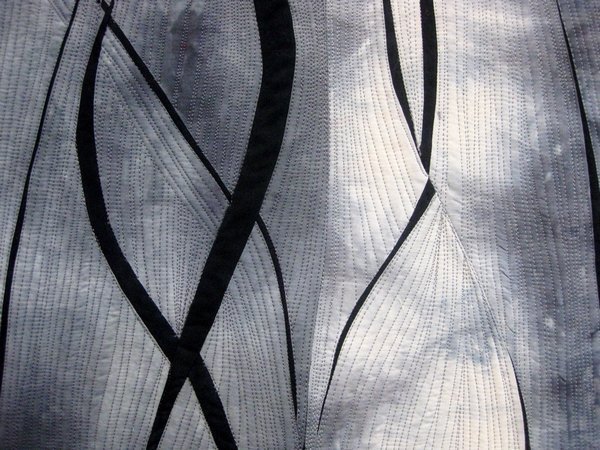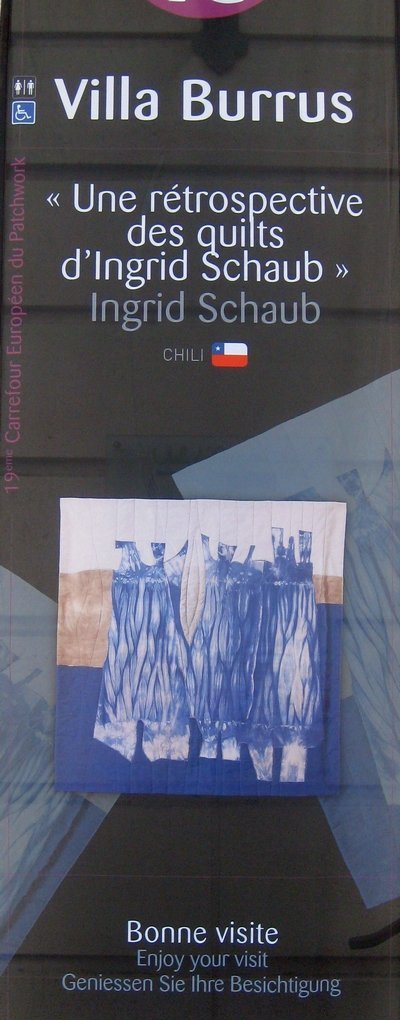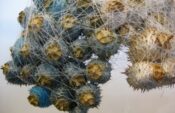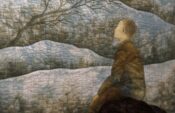The exhibition ‘Imaginations’ presents the work of three Russian art quilters, Irina Voronina, Galina Krasnikova and Nelly Savelyeva. The three quilters are highly individual in their work, using their own innovative techniques, with very different results. They have all exhibited internationally and received numerous awards for their work.
First, we come to Irina Voronina from St Petersburg, who studied art at the Repin Academy of Fine Arts and has devoted herself to quilts since 1989. She uses fabrics like paints, as brush-strokes, and through the layers of different types of fabric, she achieves depth as well as light effects.
Irina Voronina (RUS): Mirage, Eternal Wanderers Series, detail
Irina Voronina (RUS): Mirage, Eternal Wanderers Series, 2011, 160 x 89 cm
Irina Voronina (RUS): Mirage, Eternal Wanderers Series, detail
Irina Voronina in front of “White night”, 2010, 165 x 104 cm
Galina Krasnikova trained as an actress at the Russian Theatre Academy. In 2004, she encountered patchwork and since 2006 she has taught patchwork and quilting at the BERNINA training centre in Moscow. For Galina, a quilt is like a theatre in which she is simultaneously the writer, director, set designer and, of course, the actress.
Galina Krasnikova (RUS) in front of her quilt “Three Pomegranates”, 2012, 112 x 83 cm
Galina draws, dyes her fabrics, embroiders by hand and combines different materials.
Galina Krasnikova (RUS): In the Moonlight, 2013, 145 x 145 cm
Galina Krasnikova (RUS): In the Moonlight, detail
Galina Krasnikova (RUS): Pomegranate Juice, 2012, 110 x 108 cm (behind us)
While I had already met Galina and Irina in person a few years ago and had many opportunities to admire their quilts first hand, I had not encountered Nelly Savelieva before, and I was very pleasantly surprised.
Nelly Savelieva, who was born in Belarus, has an obvious favourite theme: nature, especially the landscape with all its flora and fauna, as well as a creed: “Observe and study …”. Her quilts are masterfully executed and there is a huge amount of detail to discover.
Nelly Savelyeva (RUS) in front of her work “Summer Meetings”, 2012, 140 x 200 cm
Nelly Savelyeva (RUS): The Charm of Summer Diptych, 2009, 40 x 50 cm
Nelly Savelyeva (RUS): The Charm of Summer Diptych, detail
At the organiser’s evening reception, there is an opportunity to meet people, have discussions, maintain contacts and raise a glass and toast with dear friends, such as Julia Ivanova (left, House of Folk Art, Moscow), Wolfgang Eibisch (whose generous support and translations were invaluable) and Marina Blumin (right, State Hermitage Museum, St Petersburg). Russia will be a guest country at the European Patchwork Meeting in 2014 and we can look forward to a wide-ranging exhibition of Russian quilts.
This concludes the section of my report on the Russian exhibitors. It continues with equally interesting exhibitions, such as …
… the exhibition “Traces et Mots / Tracks and Words” by Ramona Conconi (CH)
Ramona Conconi found her way to art quilting and to spontaneous, intuitive creative processes thanks to Nancy Crow. Between 2000 and 2010 she taught in her studio in Melide. Today she works as a nurse and as a textile artist.
Exhibition by Ramona Conconi (CH): Quintessenza del colore 1, 2, 3, 4 (centre), Quadratura del Cerchio, detail (right)
Ramona Conconi (CH): Quintessenza del colore 1, 2, 3
Ramona Conconi (CH): Quintessenza del colore 1, 2, 3, 4
Ramona Conconi (CH): “Quintessenza” acknowledges a connection with music, here to the song “Purple Rain””
Ramona Conconi (CH): Earth, wind & fire
Daniela Arnoldi and Marco Sarzi-Sartori – that’s DAMSS. The pair from Italy work as a team, complementing each other well in every respect, with a particular liking for experimental techniques of fabric manipulation. In their work, they only use materials that have already had a life, materials that were intended for the fashion industry, designed and manufactured, but were discarded. The result is often three-dimensional textile work and textile installations – with a monumental size.
In their exhibition ‘Textile fusions’, they principally show works involving figurative representations.
DAMSS (I): Ultima Cena (The Last Supper), 2013, 800 x 240 cm
DAMMS (I): Dôme de Milan, 2010, 160 x 160 cm
DAMMS (I): Dôme de Milan, detail
In the Espace des Tisserands however, there was not only room for the eight-metre-long Last Supper and other large formats from the creative workshop of DAMSS. Studio Art Quilt Associates (SAQA) exhibited a remarkable show entitled “Deux“:Two. Two ideas, two inspirations, two complementary quilts.
Each artist was set the challenge of creating two works in response to a theme, to a concept. To enable the two works to enter into a dialogue with each other and with the viewer, they were presented next to each another. Thanks to the individual styles, this led to some very varied interpretations. The pairs complemented each other to some extent, but they also stood in contrast to each other. A nice idea and a challenge to the visitors as well.
Beth A. Carney (USA): Chasms 7, 2011, 36 x 36″ (left), Chasms 8: Contrast Refelections, 2011, 36 x 36″
Beth A. Carney (USA): Chasms 7, detail
Beth A. Carney (USA): Chasms 8: Contrast Refelections, detail
Carol Coohey (USA): And Stands Like a Wall in Front of Your Eyes, 2011, detail (front left), The Breath Coming Out of Your Chest Turns into A Dark Cloud, 2011, 41 x30″ (centre left)
Susan Rienzo (USA): Sunshine Memories II, 2009, 47 x 48″ (li), A New Day: Sunshine Dreams and Memories, 2008, 45 x 34″
Mary Lou Alexander (USA), Civil Twilight, 2012, 30 x 40″ (li), Solar Flare, 2012, 47 x 48″
Mary Lou Alexander (USA): Solar Flare, detail
Patricia Kennedy-Zafred (USA): Dawn to Dusk: The Boys of the Mines, 2011, 44 x 39″
Patricia Kennedy-Zafred (USA): Seaside: The Girls of the Canneries, 2011, 52 x 44″
In conjunction with her students, Monique Gilbert from Belgium set up a project in 2012 in which inspiration was taken from the images of the painter Paul van Hoeydonck (born 1925). Each of the artists chose one of his pictures painted between 1951 and 1961 as the basis for a textile work – not a copy, but their own reinterpretation. The emphasis was thus on letting themselves be inspired to create their own designs, and this could happen simply through a detail, a colour or shape or the composition. They worked to a specified format of 80 x 80 cm, using their own choice of techniques. Everything else was the subject of the workshops. The result was a remarkable exhibition by the group “Crossroads” under the title “Abstraction”.
Monique Gilbert (B) in front of her work “On-Abstraction”, 2012, 80 x 80 cm, and the inspiration for this …
… is the image by Paul van Hoeydonck: Medina Fez
Michele de Cuyper (B): Black/White. Answer to Dialogue, 2012, 80 x 80 cm
Anne Mie Jansen (B): Black White in Dialogue, 2012, 80 x 80 cm
View of the exhibition “Abstraction” by the Belgian group “Crossroads”
Philippa Naylor (UK) has been involved in this art-form since 1996 and has already won many prizes with her large-scale quilts that she masterfully quilts on a machine. The trained fashion designer presented a number of her impressive works from the last ten years in her exhibition “A Decade of Quilts”.
Philippa Naylor (UK): Rising Stars (The Abandoned Family), 2001, 170 x 170 cm

Philippa Naylor (UK): Star Sign, 2007, 226 x 226 cm
Susan Dahlberg has developed a unique form of expression based on her own technique. The title of her exhibition “When the sewing machine and silk muslin replace the brush …” is a very apt description because her works look very much like paintings. Only at second glance, up close, can the viewer see …
…. that it has been embroidered. The Swede uses multiple layers of fabric that have previously been hand dyed and/or printed or painted and layers them on top of each other. The gossamer silk muslins from Japan give the whole thing luminosity and a delicate shimmer. Embroidery is then applied on the machine using the free hand technique to form a dense pattern …
Susan Dahlberg (S): The Angel’s Cry, 2004, detail
Susan Dahlberg (S):Beyond the Frozen Soil, 2009, 61 x 98 cm
The fact that Susan Dahlberg is from Sweden is evident to some extent from the references to Swedish folklore. For example, she cleverly integrates traditional weave patterns and motifs into her work, as in the embroidery “Beyond the Frozen Soil”.
Nancy Crow is one of the most respected contemporary quilt artists and is considered an authority in her field. Her quilts are unconventional and experimental, they hang in exhibitions and museums all over the world and have been influential on the scene for decades. Here, she presents works from the years 2011/2012 that introduce a new technique: mono-prints.
View of the exhibition by Nancy Crow: “Self-Portraits: Focus / Mono-prints”
Nancy Crow (USA): Mono-print #26A/#25C Short (oranges/reds), 2012, 105,5 x 101,5 cm

Nancy Crow (USA): Mono-print #26A/#25C Short (oranges/reds), detail
Jana Haklova from Pilsen (CZ) is Chair of the Bohemia Patchwork Club and thus co-organiser of the Prague Patchwork Meeting for good reason – she has always been fascinated by textile work. She is full of energy and enthusiasm, and in the last 5-10 years we have run into each other many times here and there at quilt festivals. In 2013, she finally had the opportunity to show her own original work at such a prestigious event as the EPM. Her theme is “Bridges”.
She is captivated by historic bridges, but also by the great achievements of modern architecture. Jana uses a wide range of techniques and materials for her quilts. She dyes and designs …
Jana Haklova (CZ): Venice, 2013, 124 x 69 cm
Jana Haklova (CZ): Venice, detail
Jana Haklova (CZ): Between the two cities, 2013, 143 39 cm
… her fabrics herself and finally quilts her works freehand on the machine or by hand. The result is a variety of bridge quilts, each more beautiful than the last!
Jana Haklova (CZ): Across the river, 2013, 90 x 80 cm
Jana Haklova (CZ): Across the river, detail
The Italian Fabia Delise used the other half of the church for her exhibition “Welcome change”. Both the artist and her work are very likeable. She does not completely overturn the rules of the traditional patchwork, but rather re-interprets them. She works with a limited colour palette that is very coherent and quiet, but enlivens her work by using different types of fabric. Her motifs are simple yet modern and her embroideries, created sometimes by hand, sometimes on the machine, bring excitement to her compositions.
Fabia Delise – a new and welcome young face! It will be interesting to see more of her work in future.
Fabia Delise (I) in front of her work “Il mare d’Inverno / Sea in wintertime”
Fabia Delise (I): Il mare d’Inverno / Sea in wintertime, 2013, 66 x 84 cm
Fabia Delise (I): Il mare d’Inverno / Sea in wintertime, detail
Fabia Delise (I): Luce / Light, 2010, 74 x 73 cm (li), Vent de printemps / Light breeze, 2011, 43 x 59 cm (re)
Fabia Delise (I): Vent de printemps / Light breeze, detail
Fabia Delise (I): Vent de printemps / Light breeze, detail
In my opinion, this close-up shows a good example of the combination of hand quilting, free motion machine embroidery and hand embroidery.
Fabia Delise (I): Germogli / Blooms, 2010
Fabia Delise (I): Germogli / Blooms, detail
Fabia Delise (I): Legami / Bonds, 2013, 36 x 42 cm
Fabia Delise (I): Legami / Bonds, detail
The Villa Burrus in Ste Croix-aux-Mines hosted a retrospective of the work of Ingrid Schaub, who was born in 1942 in Chile, where she was also educated, before studying textile design in Germany.
Since 1983, she has taken part in several group quilt exhibitions, including events in Germany, France and Chile. She has also had a number of solo exhibitions. She has been teaching quilt design since 1989. Her starting point was very traditional motifs, but she has followed her own personal inspiration – the exhibition displayed works of great stylistic diversity.
Ingrid Schaub (Chile): CAV-017, 2009, Detail (front left), CAV-012, 2006, 87 x 104 cm (back right
Ingrid Schaub (Chile): CAV-021, 2012, 135 x 150cm (left), CAV-016, 2007, 130 x 115 cm (right)
Ingrid Schaub (Chile): CAV-016, detail
Ingrid Schaub (Chile): CAV-005, 2009, 150 x 123 cm

Ingrid Schaub (Chile): CAV-005, detail
Finally, a look at the Eglise de la Madeleine in Ste Marie-aux-Mines, where the European guest of honour, Denmark, presented around 50 textile works.
Quilting is very popular in Denmark and the Danish Guild is very active. Thus, works by quilt artists, teachers, as well as unknown quilters were hung side by side.
For many years, one of the best known Danish textile artists exhibiting internationally has been Charlotte Yde, who is also a member of the prestigious group Quilt Art, which showed an impressive work at this exhibition:
Charlotte Yde (DK): Chaos and Order, Passage of Time, 2013, 140 x 180 cm
Charlotte Yde (DK): Chaos and Order, Passage of Time, detail
Bettina Andersen (DK): Abstract Paintings, 2013, 150 x 180 cm
Bettina Andersen (DK): Abstract Paintings, detail
However, most visitors gathered at the rear of the church, as if magnetically attracted to a double portrait of the American singer Whitney Houston created by Birgitte Busk (DK), which evoked first astonishment from viewers and then torrents of praise. At first glance they looked like detailed oil paintings, but on closer inspection a unique needle painting technique, executed on a simple BERNINA machine, was revealed.
Birgitte Busk (DK): Moments in time I & II, 2013, 110 x 110 cm (left)
The artist sticks a mosaic of single-coloured fabrics onto a substrate, guided by a photo of the subject. Then the whole thing is placed under the presser foot and embroidered with different yarns using lockstitch. That’s the whole technical secret!
Birgitte Busk (DK): Moments in time I & II
BBirgitte Busk, who has drawn faces since her early childhood, has an extraordinary talent, turning “needle painting” into something exceptional: tiny details are joined and fused together to produce the overall effect. Birgitte Busk covers the individual pieces of fabric with countless stitches concentrated together; they are no longer recognisable as such, as reflected light and shadows modulate the facial features. It is compared with the photo many times until in the end everyone can recognise the portrait.

Birgitte Busk (DK): Moments in time II, detail
This is the end of my report on the 19th European Patchwork Meeting. The three parts represent a personal journey through the various exhibitions, some of which I did not even see, and some of which I was not able to photograph. The extent and diversity of the works shown is simply huge! It would be impossible to present all of them here, but hopefully this report gives you an impression. I hope you have enjoyed it!
In any case, it is well worth coming to this event, next due to take place on 18–21 September 2014 at the same location in Alsace. This will be the 20th such event – this anniversary promises to give the event a further boost. So make sure you don’t miss it! I will be there again, showing my work in the exhibitions, and of course also as a blogger …
The first part of the report is available.
The second part of the report is available.
***
Info:
European Patchwork Meeting in Ste Marie-aux-Mines (F)
Photos, with the kind support of the organizer, © Dr. Wolfgang, Gudrun and Valerie Heinz
 BERNINA Corporate Blog -
BERNINA Corporate Blog -












































































0 Responses